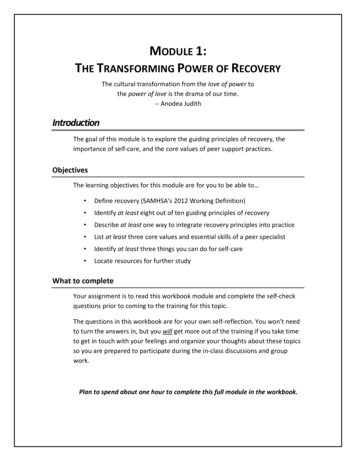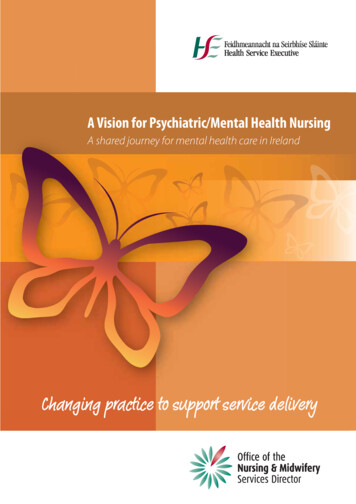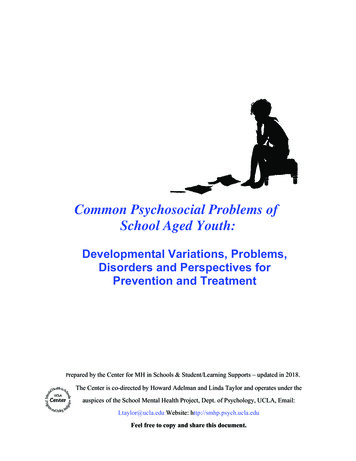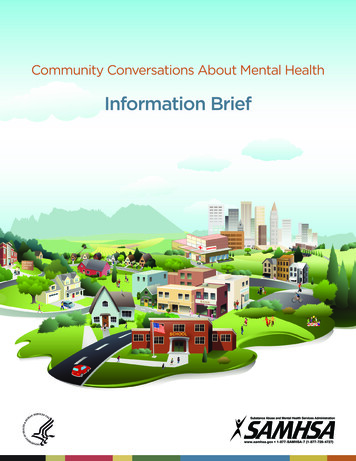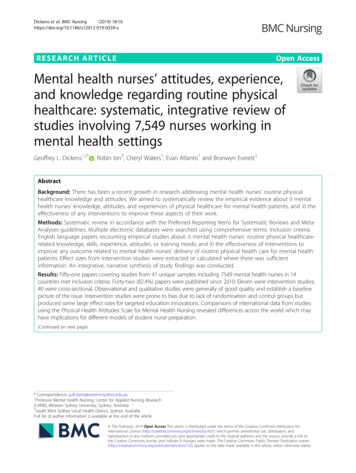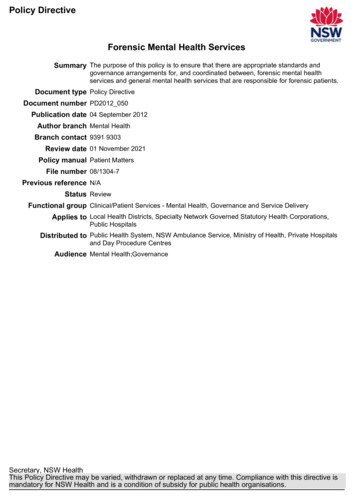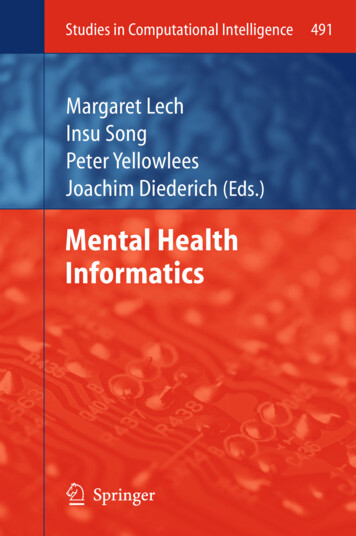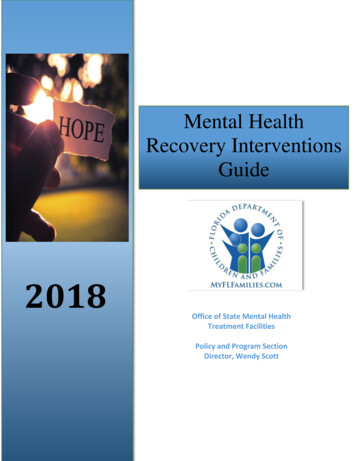
Transcription
Mental HealthRecovery InterventionsGuide2018
Table of Contents 2Table of ContentsTable of Contents . 2Disclaimer . 4Foreword . 4Acknowledgements . 5Recovery Interventions . 7Template . 8Evidence-Based Practices . 9Acceptance and Commitment Therapy .10Anger Management for Substance Abuse and Mental Health Clients .11Bipolar Management .13Cognitive Behavioral Therapy for Schizophrenia (CBT for Schizophrenia) .15Cognitive Behavior Therapy Group (CBT) .17Dialectical Behavior Therapy (DBT) .19Dialectical Behavior Therapy – HOPE Group .21Dialectical Behavior Therapy – Mindful Arts Group .23Family Psychoeducation Evidence-Based Practice (EBP) KIT .25Fitness for Fun .26Illness Management and Recovery (IMR) .28Integrated Dual Disorders Treatment (IDDT) Recovery Life Skills Program .30Living in Balance (LIB): Moving from a Life of Addiction to a Life of Recovery .32Recovery-Oriented Cognitive Therapy (CT-R) .34Seeking Safety .35Social Skills Training for Schizophrenia .37Substance Abuse Management .38Supported Employment .40Symptom Management .42Token Economy Programs .44
Table of Contents 3Promising Practices . 45Double Trouble in Recovery (DTR) .46Integrated Group Therapy (IGT) for Co-occurring Bipolar and Substance Use Disorders .48Psychiatric Rehabilitation Recovery Program .50Relapse Prevention .52Wellness Recovery Action Plan (WRAP).54Practices with Demonstrated Effectiveness . 56Exercise and Nutrition .57Life Skills .59Moral Reconation Therapy (MRT).61Narrative Therapy .63Wellness Self-Management (WSM) .65Enrichment Activities . 66
Disclaimer and Foreword 4DisclaimerThe Mental Health Recovery Interventions Guide (RIG) is not all-inclusive and the information may change withoutnotification. Interventions may be added as empirically and methodologically sound evaluations are conducted andsupported in the literature. The rankings of the interventions are subject to change. A ranking for a particularintervention may increase as new empirical research is conducted using either a more methodologically rigorousdesign, or the intervention demonstrated to be more effective than in previous analyses. The ranking of a particularintervention may decrease as new research demonstrates the intervention to be less effective than previouslyreported. Furthermore, an intervention may be eliminated entirely from the RIG in the event rigorous empiricalresearch demonstrates the intervention to be iatrogenic or potentially harmful to the target population.New versions of the RIG, as developed, will be posted on the Florida Department of Children and Families’ (DCF)website. It is the sole responsibility of the reader to ensure utilization of the most up-to-date version. Additionally,it is the sole responsibility of the reader to obtain the required training, certification, education, and licensure (ifapplicable) to facilitate any intervention described within. DCF is not liable for any licensure or copyrightinfringements by any individual or agency engaging in unlawful actions in the facilitation of the interventions within.ForewordIn 2018, a dedicated workgroup compiled a list of recovery interventions aimed at reducing symptoms of mentalillness, promoting recovery and/or competency restoration, and preventing recidivism for individuals residing inone of the seven state mental health treatment facilities. These interventions were rank-ordered into the followingthree categories: Evidence-Based Practices, Promising Practices, and Practices with Demonstrated Effectiveness.The goal of the RIG is to serve as a tool to sustain and advance efforts by providing this inventory of examinedpractices by category, as defined by DCF.The RIG is updated as new empirical research is available. The RIG will be updated with either new practices, newinformation for an intervention, or to move an intervention to a different category.Persons desiring to submit material for review for potential inclusion in the Mental Health Recovery InterventionsGuide are to follow the template format (page 8) and complete it with information for the proposed intervention.The completed form is to be submitted to the chairperson of the facility-specific research committee (or leadpsychology coordinator for facilities without a research committee). The research committee chairperson willreview the proposed intervention, check available sources, and provide a recommendation along with supportingresearch and documentation to the Director of Policy and Programs for State Mental Health Treatment Facilities(SMHTFs). A statewide committee, appointed by the Director of Policy and Programs, will review therecommendation, along with any research articles or citations included, and notify the Director of Policy andPrograms of either approval or disapproval. The Director will notify the requesting facility of the outcome, and ifapproved, will revise the RIG, disseminate to the Mental Health Treatment Facilities and post on DCF’s website.
Acknowledgements 5AcknowledgementsDCF would like to acknowledge and commend the dedicated workgroup members who conducted research andhad countless discussions regarding the criteria and how to categorize each intervention included in this guide. TheRIG would not be possible without their dedication and hard work. The DCF workgroup members included:Carolyn Drazinic, M.D., Chief of Medical ServicesKaren Galin, Ph.D. - Vice President of Behavioral Health, Correct Care Recovery SolutionsJonathan Hall – Government Analyst IIJennifer Leslie – Rehab Services DirectorDeidra Lewis – Social Services ManagerTristan Maelia – Mental Health Program AnalystTony McCoy, Ph.D. - Psychological Services DirectorJennifer McManus, Ph.D. - Psychological Services DirectorBrian Menard – Gubernatorial FellowMarguerite Morgan – Operations and Management Consultant ManagerJennifer Slusarz, Ph.D. – Senior Behavioral AnalystMarsha Sykes – Operations and Management Consultant ManagerWendy Scott – Director of Policy and Programs, State Mental Health Treatment FacilitiesJulie Tindall – Chief of Nursing ServicesJackie Young – Senior Management Analyst SupervisorDCF would like to acknowledge and thank the Florida Department of Juvenile Justice for sharing their Sourcebookof Delinquency Interventions, which inspired the creation and design of DCF’s RIG.DCF would also like to acknowledge the Substance Abuse and Mental Health Services Administration and theAmerican Psychological Association’s 2005 Policy Statement on Evidence-Based Practice in Psychology as helpfulresources in developing its definition of “evidence-based practice.”Florida State Mental Health Treatment Facilities adhered to the following criteria provided in SAMHSA’s 2009“Identifying and Selecting Evidence-Based Interventions” guidance document in the process of identifying evidencebased practices for the populations our treatment facilities serve:1. The intervention is included in a federal registry of evidence-based interventions, such as the NationalRegistry of Evidence-based Programs and Practices (NREPP) OR2. The intervention produced positive effects on the primary targeted outcome, and these findings arereported in a peer-reviewed journal OR3. The intervention has documented evidence of effectiveness, based on guidelines developed by the Centerfor Substance Abuse Prevention and/or the state, tribe, or jurisdiction in which the intervention tookplace. Documented evidence should be implemented under four recommended guidelines, all of whichmust be followed. These guidelines require interventions to be: Based on a theory of change that is documented in a clear logic or conceptual mode AND Similar in content and structure to interventions that appear in federal registries of evidencebased interventions and/or peer-reviewed journals AND Supported by documentation showing it has been effectively implemented in the past, multipletimes, and in a manner attentive to scientific standards of evidence. The intervention resultsshould show a consistent pattern of credible and positive effects. AND
Acknowledgements 6 Reviewed and deemed appropriate by a panel of informed prevention experts that includesqualified prevention researchers experienced in evaluating prevention interventions similar tothose under review; local prevention professionals; and key community leaders, as appropriate(for example, law enforcement officials, educators, or elders within indigenous cultures).
Recovery Interventions 7Recovery InterventionsThe purpose of implementing an intervention is to reduce symptoms of mental illness, reintroduceindividuals into the community by promoting recovery and/or restoring competency, and preventrecidivism for individuals in the mental health treatment facilities.There are three levels at which we define recovery interventions. The level an intervention is placed withinis dependent upon the empirical research conducted on that practice and the results of those analyses.The levels progress in terms of methodological rigor and effectiveness of the practice, with evidencebased practices requiring the highest level of rigor and the highest level of program success with resultslasting at least one year from completion. The levels and their respective definitions are as follows:Evidence-Based Practices: The integration of the best evidence from research on mental illnessinterventions with clinical expertise in the context of resident characteristics, culture, and preferences.The effectiveness of severe mental illness interventions is demonstrated by a substantial and supportingbody of evidence drawn from a variety of research designs and methodologies. More specifically,evidence drawn from clinically relevant research on psychological and mental health treatment practicesshould be based on systematic reviews, reasonable effect sizes, and statistical and clinical significancewhile recognizing limitations in the existing literature.Promising Practices: Manualized curricula that use interventions which have been evaluated and havea significant amount of empirical support for their use and efficacy among targeted populationsconsistent with the goals and objectives of the activity or program, but do not have enough datacollected or rigorous research conducted with clinical populations to meet the criteria of an EvidenceBased Practice. Programs utilizing Promising Practices are expected to demonstrate adherence to modelfidelity in practice implementation, and to actively work toward building stronger evidence throughongoing evaluation.Practices with Demonstrated Effectiveness: Practices based on general principles, strategies, andmodalities reported in psychological or other social science research as being effective with adult,mentally ill or behavioral health disorder population. These interventions have empirical support for theprinciples, theoretical framework, or components of the intervention. The specific interventions haveusually not been empirically evaluated using either random assignment or the use ofcontrol/comparison groups. For an intervention to be deemed a practice with demonstratedeffectiveness, the empirical research must have shown that practices that contain similar componentsor similar principles have shown reductions of the program participants versus the comparison group(s)in at least one treatment need. These practices should be outlined in a format that ensures consistentdelivery by a facilitator across multiple groups and/or there is evidence that replication by differentimplementation teams at different sites is possible.
Template 8TemplateName of Program and AcronymFlorida DCF Classification:Level of empirical support for the program; based on the threedefinitions of evidence-based, promising, or practice withdemonstrated effectivenessProgram AuthorProgram Person(s) who developed the interventionProgram Contact:Web address for program informationOverview:Brief synopsis of the program/curriculumRecommended Group Size:Recommended group size per sessionRecommended Frequencyand Length:Recommended length of service, number of sessions, hours, andany specific requirements for deliveryTherapeutic Focus:Diagnosis of focus, presenting problems or issues, dischargebarriers, and treatment targetProven Outcomes:Demonstrated benefits of treatmentPopulation:Targeted segment of DCF populationTreatment Setting:Therapeutic settings in which this intervention has been successfulModality:How the program/curriculum is deliveredFacilitator Training &Certification:Type of training and/or certification needed to facilitate thecurriculumBibliography:A reference list identifying the rigorous research conducted on theprogram. The reference list is not exhaustive, but is meant toprovide information as to the types of analyses conducted on theprogram and results garnered.
Evidence-Based Practices 9Evidence-Based Practices
Evidence-Based Practices 10Acceptance and Commitment TherapyAcceptance and Commitment TherapyFlorida DCF Classification:Evidence-Based PracticeProgram Author:Steven C. Hayes, Ph.D., Kirk D. Strosahl, Ph.D., Kelly G. Wilson, and Ph.D.Program /onelifellc.com/Overview:The use of acceptance and mindfulness strategies help clients to be fullypresent in the moment and to accept otherwise negative emotions.Commitment and behavior change strategies help clients to change orpersist in behaviors more in line with their own values. Used togetherthese strategies increase client’s psychological flexibility.Recommended Group Size:Tailored to fit the needs and resources of the context and populationRecommended Frequencyand Length:Approximately 12 1-hour weekly sessionsTherapeutic Focus:Depression and anxietyProven Outcomes:A-Tjak, Davis, Morina, Powers, Smits and Emmelkamp (2015) conducteda meta-analysis of 39 randomized controlled trials on the efficacy ofacceptance and commitment therapy (ACT), including 1,821 patientswith mental disorders or somatic health problems. Their findingsindicated that ACT is more effective than treatment as usual or placeboand that ACT may be as effective in treating anxiety disorders,depression, addiction, and somatic health problems as establishedpsychological interventions such a cognitive behavioral therapy.Population:Adults experiencing symptoms of depression, anxiety, addiction, andsomatic health problemsTreatment Setting:Inpatient and outpatientModality:Individual or groupFacilitator Training &Certification:Licensed therapists or psychologists (or therapists supervised by alicensed therapist or psychologist) with education and training inAcceptance and Commitment TherapyBibliography:A-Tjak J, G, L, Davis M, L, Morina N, Powers M, B, Smits J, A, J,Emmelkamp P, M, G, A Meta-Analysis of the Efficacy of Acceptance andCommitment Therapy for Clinically Relevant Mental and Physical HealthProblems. Psychotherapy and Psychosomatics 2015; 84:30-36
Evidence-Based Practices 11Anger ManagementAnger Management for Substance Abuse andMental Health ClientsFlorida DCF Classification:Evidence-Based PracticeProgram Author:Center for Substance Abuse Treatment (CSAT), Substance Abuse andMental Health Services Administration; Publication writer: Patrick M.Reilly, Ph.D.Program Contact:CSAT: 240-276-1660; Dr. Reilly: Patrickreillyphd@gmail.comOverview:The treatment model described in this Anger Management interventionis a combined Cognitive Behavioral Therapy (CBT) approach thatemploys relaxation, cognitive, and communication skills interventions.The purpose of the Anger Management group is to: (1) Learn to manageranger (2) Stop violence or the threat of violence (3) Develop self-controlover thoughts and actions (4) Receive support and feedback from others.Recommended Group Size:The ideal number of participants in a group is 8, but groups can rangefrom 5 to 10 members.Recommended Frequencyand Length:Twelve, 90-minute weekly sessionsTherapeutic Focus:Individuals who have a past history with poor management of anger anda lack of understanding how anger manifests; alcohol use or abuseproblems, substance use or abuse problems, mental healthProven Outcomes:A meta-analysis (Beck, 1998) reviewed 50 studies involving 1,640participants and found individuals receiving CBT for anger managementhad greater anger reduction outcomes than individuals who wereuntreated. Meta-analysis studies (Edmondson & Conger, 1996; Trafate,1995) conclude that there are moderate anger reduction effects for CBTinterventions, with average effect sizes ranging from 0.7 to 1.2(Deffenbacher, 1999). In studies at the San Francisco Veterans AffairsMedical Center and San Francisco General Hospital using this treatmentmodel, decreased substance use has also been found (Reilly, Shopshire,Clark, Campbell, Ouaou, & Llanes, 1996).Population:Adult male and female substance abuse and mental health clients (age18 years and above). Recommended that participants be abstinent fromdrugs and alcohol for at least 2 weeks prior to joining the angermanagement group.Treatment Setting:Inpatient, Outpatient
Evidence-Based Practices 12Anger ManagementModality:Individual, group therapy (recommended)Facilitator Training &Certification:Counselors and social workers should have training in cognitivebehavioral therapy, group therapy, and substance abuse treatment(preferably, at the master’s level or higher; doctoral-level psychologistshave delivered the anger management treatment as well).Bibliography:Beck, R., and Fernandez, E. (1998). Cognitive behavioral therapy in thetreatment of anger: A meta-analysis. Cognitive Therapy and Research,22, 63-74.Edmondson, C.B., and Conger, J.C. (1996). A review of treatment efficacyfor individuals with anger problems: Conceptual, assessment, andmethodological issues. Clinical Psychology Review, 10, 251-275.Reilly, P.M. & Shopshire, M.S. (2012). Anger Management for SubstanceAbuse and Mental Health Clients: A Cognitive Behavioral TherapyManual. HHS Pub. No. (SMA) 13-4213. Rockville, MD: Center forSubstance Abuse Treatment, Substance Abuse and Mental HealthServices Administration, 2002.Reilly, P.M.; Shopshire, M.S.; Clark, H.W.; Campbell, T.A.; Ouaou, R.H.;and Llanes, S. (1996). Substance use associated with decreased angeracross a 12-week cognitive-behavioral anger management treatment. In:NIDA Research Monograph: Problems of Drug Dependence, Proceedingsof the 58th Annual Scientific Meeting, College on Problems of DrugDependence. Rockville, MD: National Institute on Drug Abuse.Trafate, R.C. (1995). Evaluation of treatment strategies for adult angerdisorders. In: Kassinove, H. (Ed.), Anger Disorders: Definition, Diagnosis,and Treatment (pp. 109-130). Washington, DC: Taylor and Francis.
Evidence-Based Practices 13Bipolar ManagementBipolar ManagementFlorida DCF Classification:Evidence-Based PracticeProgram Author:Ad Adjunctive Cognitive Behavioral Group Treatment Program for BipolarDisorder. Second edition. Louella Lim, Laura SmithProgram Contact:Centre for Clinical Interventions, Perth, Western Australia.www.cci.health.wa.gov.auOverview:The Centre for Clinical Interventions (CCI) Bipolar Program is an adjunctivepsychosocial treatment program for people with bipolar disorder. Theprimary aim of the program is to help people improve their coping withbipolar disorder. The psychosocial training program addresses issuesspecifically related to the Bipolar Condition (mixed with depression andmania).Recommended Group Size:Six to eight participantsRecommended Frequencyand Length:The Lam Manual is designed for 12 to 18 individual weekly sessions, followedby 2 booster sessions over the next 6 months.Therapeutic Focus:Focuses on teaching individuals to monitor mood symptoms, recognize earlysigns of episodes, and be able to distinguish this condition from MajorDepression or Dysthymia (Persistent Depressive Disorder). It providesstrategies in managing episodes of mania and depression. Increasing knowledge about the dynamics of Bipolar Depression Distinguish between Bipolar, Major Depression, and Dysthymia Increase the ability to manage depressive and manic episodes Develop a personal plan for Bipolar management of symptomsProven Outcomes:The CCI Bipolar Program is adjunctive psychosocial treatment program forpeople with bipolar disorder. It has been developed and tested at CCI overthe last 7 years. The changes in the Second Edition of the manual reflect acontinuous process of review and evaluation of the program, and materials.Population:Bipolar disorderTreatment Setting:Community Mental Health, Rehabilitation, hospital and private officepractices Treatment Facility, and Substance Abuse Treatment CenterModality:Individual, group therapy (recommended)
Evidence-Based Practices 14Bipolar ManagementFacilitator Training &Certification:Experience in CBT and in working with people with Bipolar Disorder. CCIoffers a series of clinically relevant workshops in evidence-based treatment.These workshops have a practical, skills-based focus and have been evaluatedpositively by past participants. The workshops are suitable for all mentalhealth practitioners. Some of the workshops do require experience in usingCBT, however, the CBT Foundation Course is suitable for mental healthpractitioners with no previous experience of CBT, and provides a good basisfor completing the other workshops.Bibliography:Lam, D. H., Hayward, P., Watkins, E. R., Wright, K., & Sham, P. (2005). Relapseprevention in patients with bipolar disorder: Cognitive therapy outcome after2 years. American Journal of Psychiatry, 162, 324-329.Lam, D. H., McCrone, P., Wright, K., & Kerr. N. (2005). Cost-effectiveness ofrelapse-prevention cognitive therapy for bipolar disorder: 30-month study.British Journal of Psychiatry, 186, 400-506.Lam, D. H., Watkins, E. R., Hayward, P., Bright, J., Wright, K., Kerr, N., et al.(2003). A randomized controlled study of cognitive therapy of relapseprevention for bipolar affective disorder: Outcome of the first year. Archivesof General Psychiatry, 60, 145-152.Miklowitz, D. J., Otto, M. W., Frank, E., Reilly-Harrington, N. A., Kogan, J. N.,Sachs, G. S., et al. (2007). Intensive psychosocial intervention enhancesfunctioning in patients with bipolar depression: Results from a 9-monthrandomized controlled trial. American Journal of Psychiatry, 164, 1340-1347.Patelis-Siotis, I., Young, T. L., Robb, J. C., Marriott, M., Bieling, P. J., Cox, L. C.et al. (2001). Group cognitive behavioral therapy for bipolar disorder: afeasibility and effectiveness study. Journal of Affective Disorders, 65, 145-153.Scott, J., Paykel, E., Morriss, R., Bental, R., Kinderman, P., Johnson, T. et al.(2006). Cognitive behavioural therapy for severe and recurrent bipolardisorders: A randomised controlled trial. British Journal of Psychiatry, 188,313-320.
Evidence-Based Practices 15Cognitive Behavioral Therapy for Schizophrenia (CBT for Schizophrenia)Cognitive Behavioral Therapy for Schizophrenia(CBT for Schizophrenia)Florida DCF Classification:Evidence-Based PracticeProgram Author:Informed by the following authors on CBT for Schizophrenia:Beck, J.S. (2011), Chadwick, P., Birchwood, M., & Trower, P. (1999), Kingdon,D.G., & Turkington, D. (1994), Morrison, A.P., Renton, K.C., French, P. &Bentall, R.P. (2008), and Smith, L., Nathan, P., Juniper, U., Kingep, P., & Lim,L. (2003).Program w:Founded on the general principles of cognitive behavioral therapy (CBT) andincorporates techniques and skills that address many of the positivesymptoms (i.e., delusions, paranoia, hallucinations) associated withschizophrenia spectrum disorders. CBT is a well-established, empiricallyresearched therapy that encourages individuals to understand theconnection between their thoughts, feelings, and behaviors. Once thisconnection is made, group members are encouraged to gradually challengetheir thinking patterns and behaviors using CBT interventions taught anddemonstrated by the group facilitator. In addition to regularpsychoeducation on schizophrenia, examples of group topics includedistinguishing thoughts from emotions, understanding the connectionbetween thoughts and emotions, identifying and labeling cognitivedistortions, and introduction to though records. Examples of interventionstaught to group members include how to conduct behavioral experiments,relaxation techniques, creating coping cards, and reality testing skills.Recommended Group Size:8-15Recommended Frequencyand Length:Ongoing, five 1-hour sessions per weekTherapeutic Focus:Individuals with schizophrenia spectrum disorder diagnoses with an interestin understanding and coping with their symptomsProven Outcomes:Dickerson (2004) reviewed 17 recent clinical trial studies involving CBT forSchizophrenia. The studies involved four different groups, which are asfollows: patients with recent onset psychosis, patients with persistentsymptoms from community settings, patients with high symptom severityprimarily in long term inpatient settings, and patients with specific comorbiddiagnoses. Meta-analysis from formal effect-size analysis indicate effectsizes of from .65 to 1.25 lending support that CBT is an effective adjunctive
Evidence-Based Practices 16Cognitive Behavioral Therapy for Schizophrenia (CBT for Schizophrenia)treatment for some patients with schizophrenia. While the most robustfindings were for outpatient populations, inpatient populations experiencedimprovement in self-esteem, lower total and positive symptoms, and greaterimprovement in their cognitive interpretation of auditory hallucinations andin the physical characteristics of the hallucinations.Population:18-25 (young adult), 26-55 (adult), 55 (older adult), civil or forensicTreatment Setting:Inpatient and outpatientModality:Group or individual therapyFacilitator Training &Certification:Licensed therapists or psychol
Recovery Interventions 7 Recovery Interventions The purpose of implementing an intervention is to reduce symptoms of mental illness, reintroduce individuals into the community by promoting recovery and/or restoring competency, and prevent recidivism f
